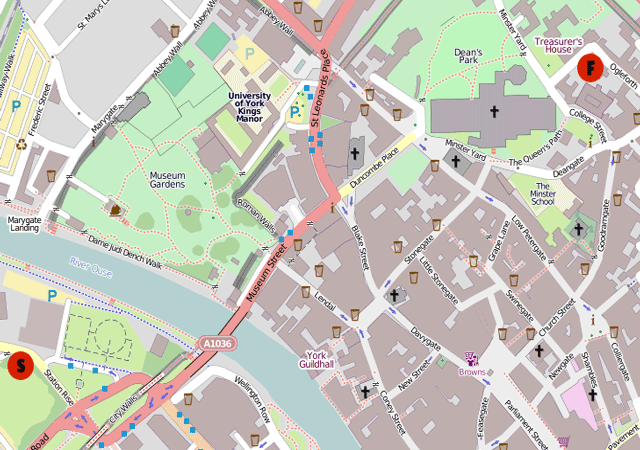Anybody who has travelled to another country or city has got lost. Sometimes maps don't help, so you have to ask somebody for directions. If you're in a country where they don't speak your language, this can be difficult. At other times, you will have to give directions to people visiting your country. In many cases, people just follow the direction the person was pointing to, and hope they will find the place they are looking for. So, it's very important to know how to both ask for and give directions in English.
In this online exercise, we will look at the essential vocabulary used to both ask for and to give directions in English.
Exercise: Receiving directions
A visitor to the city of York in the North of England asks a person in the street for directions to the Silk Cottage restaurant. Read the directions that she is given and compare them with the below map of York that shows the route. The visitor receives the directions at the red marker with the letter 'S' on the left of the map. The restaurant is located where the red marker with the letter 'F' is, at the top right of the map.
Using both the directions and the map, try to guess what the meaning of the words/phrases in bold are. Then do the quiz at the end to check if you are right.

Visitor:'Excuse me, could you tell me the way to the Silk Cottage restaurant please?'
York Resident:'Eh, the Silk Cottage restaurant. It's on the other side of the river. The easiest way to get there is to go right from here and then take the second street on your left. Then go along the street until you reach a junction. Turn left at the junction, and you'll be on a big road then. Then go straight ahead.
You'll then come to a bridge, go over the bridge. It is better to cross over the road after the bridge, there's a pedestrian crossing there. Then follow the road until you reach a big church, which is called York Minster. Take the road on your right which is in front of York Minster and then go past the Minster.
Then take the first street on your left, then go up the road until the first street on your right and the Silk Cottage restaurant is there. Opposite is a big building called the Treasurer's House. Is that ok?'
Quiz: Street directions in English vocabulary
Listen to the recording in English of a man giving directions to the 'Yorkshire Insurance Building' in Leeds. They are both at the red S marker at the bottom of the below map. The Yorkshire Insurance Building is one of the three blue markers at the top of the map. Follow the directions and complete the dialogue below with the man's instructions, by choosing the word/phrase from the question's selection box. In the last question choose if the location of the Yorkshire Insurance Building is A, B or C.
Click on the "Check Answers" button at the bottom of the quiz to check your answers.
When the answer is correct, two icons will appear next to the question. The first is an Additional Information Icon " ". Click on this for extra information on the word/phrase and for a translation. The second is a Pronunciation Icon "
". Click on this for extra information on the word/phrase and for a translation. The second is a Pronunciation Icon " ". Click on this to listen to the pronunciation of the word/phrase.
". Click on this to listen to the pronunciation of the word/phrase.

Visitor:'Excuse me, I'm looking for the Yorkshire Insurance Building, do you know where it is?'
Leeds Resident:
Practice
Now that you understand the ask for/give directions vocabulary, practise it by describing different routes on the maps in English or by decribing how to get to your office or house.
Follow us on  or on Twitter
or on Twitter 



